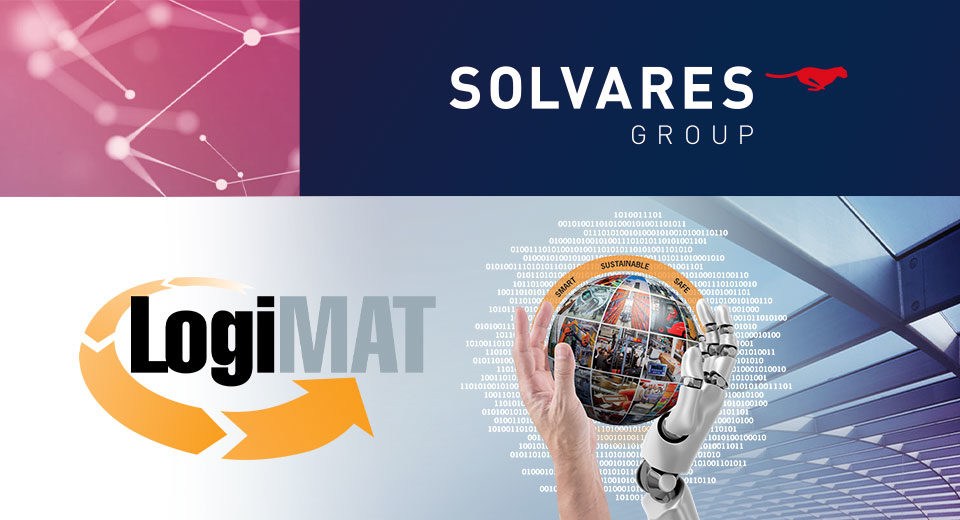
BLOG
CLOUD-BASED SOFTWARE
WHAT IS CLOUD-BASED SOFTWARE AND HOW DO YOU BENEFIT FROM SOFTWARE-AS-A-SERVICE (SAAS)?
Cloud-based software and software-as-a-service (SaaS): definition as well as advantages and disadvantages of the modern usage model of software
__________________

15 November 2022 · Christoph Bertram
Cloud-based software and software-as-a-service (SaaS) have become the standard model of software use, no more so than the logistics and field service industries. Read here how the model works and what exactly it means for companies who've chosen to use software via the cloud instead and replace on-premise.
When was the last time you bought a software programme on physical media, perhaps even from a local supplier? Classic physical media, even those download codes in plastic boxes had their day as soon as enough bandwidth became available. The same is apparent for the use of software in companies: The sale and operation of software has shifted to the internet and therefore, to the so-called cloud. As a result, the principle of software-as-a-service is becoming increasingly popular and could even replace the classic 'purchase' of software altogether in the future.
CLOUD-BASED SOFTWARE: WHAT ARE CLOUD TOOLS?
Cloud-based software or cloud-hosted tools refers to software and services that are made available via the internet. Cloud-based software are programmes that do not have to be installed on the user's own device. Instead, they are hosted on the provider's servers and users access them via the internet to work with them. This means that cloud software can basically be used via any end device that has internet access.
HOW THE SOFTWARE-AS-A-SERVICE (SAAS) CONCEPT WORKS
Software-as-a-Service (SaaS) is a subset of cloud computing. The model aims to eliminate the need for users to purchase software licences and physical copies of programmes. They only pay to be able to use the respective tool and its functions via the cloud.
Software developers and vendors offer software-as-a-service mostly in the form of different subscription models. The user no longer buys the software (permanently), but merely uses it (for an appropriate time). The software and its use are provided 'as a service'; no longer as a singular product. The principle is comparable to the difference between car-sharing and buying a car.
The advantage for users: With SaaS, you require far fewer IT infrastructures and resources of your own. All organisations need is a suitable end device and an up-to-date web browser as well as internet access. No more complex installation and no more hosting of the software on their own servers. Used correctly, Software-as-a-Service can save you money and still keep your work running efficiently.
WHAT IS THE OPPOSITE OF SAAS?
The opposite of software-as-a-service and cloud-based services are so-called on-premise solutions: Here, users purchase a licence for the respective programme and install it at their premises. This means that they buy or rent it and then must set it up on their end devices or in their own data centre. Therefore, on-premise means as much as 'on-site', 'local' or effectively 'on one's own premises'.
This also applies to updates: The users must complete these themselves. Since each software installation is an autonomous version, the individual users and computers often must be linked manually via the company's own network. For a long time, the on-premise model was the standard for the use of software, but since around 2010, local use has increasingly been replaced by use via the cloud and the software-as-a-service (SaaS) model.
THE TRIUMPH OF CLOUD SOFTWARE
Nowadays, cloud-based software is widely used: According to the Cloud-Monitor 2022, a study conducted by Bitkom on behalf of KPMG, 84 percent of companies in Germany already use cloud solutions - compared to only 37 percent in 2012. More and more solutions for logistics, sales, maintenance and field service are also being run via the cloud and are no longer installed at or by the user company.
The trend towards the cloud, which started mainly in HR software, CRM systems and office and communication applications, is continuing in other areas. The Corona pandemic has reinforced it, because the cloud is made for decentralised working beyond the company headquarters. Cloud-based tools are predestined for logistics and field service processes, as employees can access the software from anywhere via web services.

THE CLOUD PLATFORM FOR SERVICE & MAINTENANCE
The mobileX-ServicePlatform is the perfect solution for your entry into the digitalisation of your processes, starting with just a few resources.THE CLOUD IS THE NEW CENTRE OF A COMPANY
In everyday life, few people are aware of how many of their daily work processes now run via the cloud. This starts with internal communication: If you don't have a colleague in front of you in person, you often use a messenger or a tool designed for internal communication and collaboration. No matter whether you're using Microsoft Teams, Skype, Slack, or Zoho Cliq - they all send their messages via the internet and store the data in the cloud.
Cloud-based software can play out one of its greatest advantages in communication and organisation: It is available to all users at the same time and synchronises all data in real time – exactly what you need in this respect. But cloud-based solutions and software-as-a-service are now also ubiquitous in other areas such as deployment planning, time recording, resource planning or personnel management.
DATA SECURITY AND DATA PROTECTION IN THE CLOUD
Last but not least, software from the cloud is ideally suited for data backup: by regularly storing and synchronising company data on the provider's external servers, reduces the risk of complete data loss in the event of technical problems or a virus attack at your premises. No wonder, then, that cloud computing is now state of the art and widely established as the best solution in this regard.
Many companies were initially sceptical about the cloud, especially because of concerns about data protection. This is understandable at first, since their own data and that of their customers are stored elsewhere with this model than (only) in their own data centre.
Since the introduction of the GDPR, there is clarity regarding how the data is to be processed and protected. Access via the cloud is encrypted and the European providers of cloud software, if only out of self-interest for their business model, place value on highest data security standards.
THE ADVANTAGES OF SOFTWARE-AS-A-SERVICE AT A GLANCE
The main reason for the resounding success of Software-as-a-Service is that the principle - properly implemented - is a profit for all involved.
Software developers no longer must make expensive and risky upfront investments when developing new programmes and features. Instead, they can generate revenue more quickly with their software in the cloud, which they can in turn invest in support and the further development and improvement of their programme. This results in more sustainable and coherent software solutions with more features and better operation.
There are also numerous advantages through SaaS for the users, from the costs to the flexible use of the software.
ADVANTAGES OF SOFTWARE-AS-A-SERVICE (SAAS)
Subscription model with low initial costs
Simple scalability
Maintenance, monitoring & backups are carried out by the provider
➤ SAAS OFFERS CLEARLY CALCULABLE COSTS
For companies that use software-as-a-service as a true service, the lower costs are often the most important argument: On the one hand, there is no initial investment in expensive software licences with SaaS. The entry threshold is therefore lower. This makes the model particularly interesting for SMEs. They also benefit particularly from the outstanding scalability of software from the cloud, which enables rapid growth, as well as the clear monthly costs.
On the other hand, software-as-a-service reduces ongoing IT expenses in most cases: regardless of whether it is a small company with an external IT service provider or a large corporation with its own IT department – the switch to software-as-a-service is almost always cheaper than installing software with the same range of functions on-site (on-premise) and regularly updating and maintaining it. At the same time, there is no more downtime due to maintenance work and the latest and most powerful version of the software is always available from the cloud everywhere.
➤ CLOUD SOFTWARE SUPPORTS ALTERNATIVE WORKING MODELS
In view of the change that is currently taking place with regard to different working models, software-as-a-service scores with another major advantage: employees are no longer as dependent on their work computer in the office when the company uses software from the cloud. Because they can use the programmes both with the home computer in a home office as well as with a laptop, tablet or smartphone while on the move.
Accordingly, cloud computing supports the move away from traditional compulsory attendance and helps companies to establish alternative working models. One example from the portfolio of our group of companies: With Opheo 7, the new version of the digital transport control center, even the Truck scheduling from a home office or other remote location can happen seamlessly.
➤ SOFTWARE-AS-A-SERVICE IS FLEXIBLE AND ADAPTABLE
While companies tie themselves down for the long term by purchasing an expensive software licence, they remain flexible with a software-as-a-service solution. Many providers also offer demos or offer free test phases or trial versions. With cloud software, it is easier to try out different options and find the best solution. At the same time, most software-as-a-service solutions easily scale for an added element of 'future-proofing'.
Another important factor is that many SaaS offerings are available in different versions. Prices are often at least slightly scaled according to the number and scope of functions, the number of users, or the bandwidth required. This opens up further potential to save compared to a traditional software licence.
CLOUD SOFTWARE AND SAAS IN LOGISTICS
Processes in logistics require a particularly high level of data accuracy and the networking of all participants. The exchange along the supply chain must function smoothly, regardless of the location of the employees and service providers. That's why cloud-based software is made for logistics.
The constant synchronisation of data in the cloud is ideal for real-time communication. Via Web-based order awarding, Tendering portals and other web services, collaboration with external service providers can also be organised. Cloud solutions and SaaS offer the flexibility and scalability, required today for efficient supply chains and dynamic logistics.

THE DIGITAL TRANSPORT CONTROL CENTRE
With OPHEO, the software for your transport management, automate your truck scheduling. On-premise or in the cloud.The range of cloud-based software and SaaS for logistics extends from comprehensive transport management systems (TMS) about the truck route planning and scheduling to warehouse management systems (WMS). Logistics software manufacturers often offer their systems both on-premise and as SaaS solutions. The move from an old on-premise programme to a new system as software-as-a-service is attractive, however, not least because cloud tools can be implemented much more quickly.
CLOUD SOFTWARE AND SAAS IN FIELD SERVICE AND SALES
In field service and field sales, cloud-based solutions are particularly important in the area of CRM (Customer Relationship Management). SaaS solutions offer the advantage that all employees have access from everywhere and the data is constantly synchronised. This makes centralised customer (data) management possible.
The advantages of the cloud also offer themselves for the scheduling and coordination of field service. Field employees and the mobile workforce may access the system while on the road. They can feed information from customer appointments or on-site assignments directly back into the software, so that the office staff and everyone involved are always up to date. Modern field service solutions and asset maintenance software from the cloud can be easily integrated with a leading CRM and/or ERP system. The same applies to software for route planning and tour optimisation.
Also becoming increasingly popular in field service are professional apps. Whether personal route-planner for individual sales representatives or a Field Service App for teams that connects to the central system: Modern apps increase efficiency and networking in the company and are often even equipped with an offline function so that critical data-led workflows are possible even when there is no network.
CLOUD-BASED SOFTWARE HELPS WITH THE TRANSFORMATION
Cloud software and software-as-a-service are big drivers of digital transformation in companies. The SaaS model promotes a lean own system architecture and location-independent access via the network, creating critical flexible working. Especially in areas such as logistics and field service, where many processes are decentralised, cloud solutions are ideal. Wherever the individual employees are, they can use the software and still all work in the same place: in the cloud.
Further suitable contents:
Software strategy: best-of-suite or best-of-breed?
Case study: Pistor AG - 3 temperature zones in 1 transport




